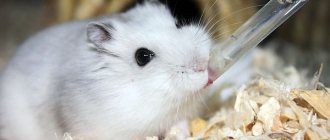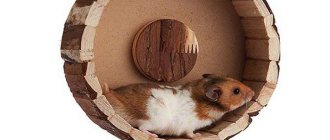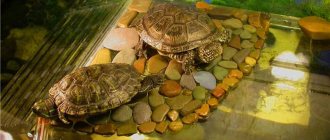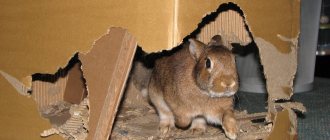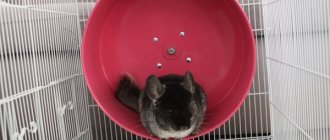- home
- Housing
13.04.2018
Hamsters are by nature very active animals. In the wild, they run 10-12 kilometers during the day. Therefore, at home you should try not to limit their activity, especially since active movements have a positive effect on their health. Even if there is a wheel in the cage, the hamster gets bored running around only in it. To restore interest in movement, caring owners buy or make a walking ball for their hamster with their own hands.
DIY walking ball for a hamster
Hamsters are by nature very active animals. In the wild, they run 10-12 kilometers during the day. Therefore, at home you should try not to limit their activity, especially since active movements have a positive effect on their health. Even if there is a wheel in the cage, the hamster gets bored running around only in it. To restore interest in movement, caring owners buy or make a walking ball for their hamster with their own hands.
Description and purpose
Small rodents, including hamsters, are active animals. In the wild, in search of food, they are able to cover about 10 km per day, which is their natural need, as well as a necessity for body tone.
But in everyday life, not many of us have the resources to provide the rodent with such conditions for freely spending excess energy. Therefore, leading scientists have created a sufficient number of various sports accessories for hamsters.
Did you know? Hamsters were discovered by English naturalists Alexander and Patrick Russell in the middle of the 18th century near the city of Aleppo
(Syria).
The most effective among them is the walking ball (walking sphere). It is a transparent plastic sphere consisting of 2 halves, as well as a small door for the rodent.
To ensure the necessary comfort, the ball is equipped with several ventilation holes to allow oxygen to enter inside. Through the door, the rodent gets inside the sphere, after which the active running of the animal sets it into motion.
This device allows the baby to move freely around the room or apartment. This allows him to maintain the necessary activity, as well as periodically change the environment, which is important for the psychological state of the rodent.
Today there are many models of such a device, but they are all divided into simple and with a trajectory of movement.
The simple ones are an ordinary smooth plastic ball; the more advanced ones have special restrictive grooves that help the animal more clearly adhere to the intended trajectory of movement.
Which breed of domestic hamster to choose: Syrian hamster, Djungarian hamster, steppe hamster.
Often the ball comes with special stands that secure it in a certain position, in which case it functions like a sports wheel.
The walking area has many advantages for both the animal and its owner, let’s consider them in more detail:
- the ball allows the rodent to keep itself in the necessary sports shape and, unlike a simple wheel, contributes to the maximum load on the body;
- allows the hamster to safely walk around the apartment;
- helps to increase the living space of the hamster;
- The ball has a low cost and is also easy to care for and use.
Did you know? Hamsters are able to carry a mass of food in their cheek pouches, which is equal to about 20% of their own weight.
Why does a hamster need a walking ball?
First of all, a walking ball is necessary for the hamster to lead a full active life and not experience a lack of movement. It allows you to leave the cage and expand the habitable space for the hamster. This will diversify his life and have a beneficial effect on his health.
Inside the ball, the pet will be able to explore the apartment on its own, moving its vehicle with its strong legs in any direction. The rodent will not be able to hide somewhere under the bed or behind a closet; it will always be in plain sight. But you should not leave the hamster unattended during these 15-20 minutes while he is inside. This is how long experts advise a hamster to stay in the area at home. Situations are dangerous when there are other four-legged animals at home. They will definitely want to play with the ball and may injure the hamster inside. The likelihood of injury is high if the hamster is on the second floor of the house. If the sphere rolls down the stairs, it can break, injuring the rodent with fragments. In such cases, it is better to limit the area of movement.
How to teach your baby to take active walks
Introduce any innovations into the animal’s life gradually. To ensure that your pet enjoys traveling in a ball, start getting acquainted with a new item in a few minutes. Gradually increase your walking time.
Monitor your pet's behavior. If the animal does not like this kind of entertainment, do not force it to walk in the ball. Stress will negatively affect the hamster's condition and a walk will not be beneficial.
To interest the animal, place a treat in the circle for the hamster - an apple or other fruit. The animal will reach into the ball to pick up the treat. Now rotate the sphere a little so that the rodent understands the “principle of operation” of the device. Noise, loud sounds and sudden movements will negatively affect learning. Patiently teach your rodent how to use a new toy until he begins to take walks on his own.
Do not forget to monitor the time the animal remains in the ball. Stop the fun in time.
Principles of use:
- Carefully place your pet into the device and close the door tightly.
- Lower the animal to the floor. Do not leave the ball on a table or other high objects. A fall will have a negative impact on the baby.
- Protect ledges and stairs from which the ball could roll.
- Limit other pets' access to the hamster's "running area". The toy will interest the animals and they will start playing with it. This will create stress for the rodent. He may get injured.
- Don't push the sphere. Khoma must drive his “transport” independently.
- Do not put several individuals in one ball.
Disadvantages of purchased hamster wheels
There are a wide variety of walking balls for hamsters on sale. They can be of any colors and sizes. It is necessary to select a walking ball in accordance with the size of the hamster. For dzhungariks, its diameter should not be too large, otherwise he simply will not have enough strength to move it. For Syrians, too small a space inside will not allow them to move their paws freely. In both the first and second cases, the hamsters will quickly get tired. If you decide to make a walking ball with your own hands, then you need to take into account all the disadvantages by building the optimal and safe accessory for your pet.
In purchased walking balls, the fastening of the lid weakens over time, and the lower the quality of the product, the more often you need to monitor this. After all, if a hamster falls out of the sphere while walking, it risks falling into the paws of a cat or dog, and household members may also step on it.
Like any product, a walking ball costs money. The price depends on the quality of the material and size. On average, the cost varies from 300 to 2 thousand rubles. You can save money if you make it yourself from scrap materials. This craft will not take much time and will diversify your leisure time.
How to make a walking ball?
For various reasons, hamster breeders are unable to purchase a special walking ball from a pet store. For example, a suitable accessory may not be available, or may not be available at all. You can easily make a suitable temporary replacement yourself.
The material can be anything, it is important that the basic conditions are met:
- Transparent walls;
- suitable in size;
- reliable fixation of the lid;
- the presence of ventilation holes.
The most suitable material is transparent plastic. Through its transparent walls it will be easy for the hamster to navigate in space. In addition, you can quickly and easily make a hamster ball from it yourself.
Plastic bottle
Plastic bottles are the most affordable item suitable for making a walking ball. The advantage of this material is its lightness and smooth transparent walls. The hamster will be comfortable inside. Make ventilation holes without sharp, ragged edges, otherwise the hamster risks scratching its paws until they bleed. Make all the holes at the bottom of the bottle and at the neck. A large number of ventilation holes will promote favorable air circulation.
Plastic bucket
In a similar way, you can make a walking ball from a plastic grocery bucket. The container should be made of lightweight transparent plastic. After thorough washing, holes are drilled in the lid and bottom of the bucket. They can be made with an awl.
When making a walking capsule with your own hands, you need to pay great attention to the following characteristics:
Size
The ability to choose a container that is suitable in size for a particular animal is one of the advantages of a homemade accessory. Sometimes you should observe the animal in walking capsules of different diameters to understand which one will be more comfortable.
The walking ball should not be too heavy, otherwise it will be difficult for the animal to move it from its place.
The diameter should be large enough so that the hamster does not have to bend his spine. You should focus on the size of the industrial balls: for Dzungarians it will be 12-13 cm in diameter, and for larger Syrians it will be about 18-20 cm, occasionally up to 30 cm.
Ventilation
You cannot put the animal into a plastic container or bottle without holes. Ventilation must be sufficient for free access of oxygen, because the animal will actively move in the toy. If there is a feeling of a greenhouse effect, then the number of holes is not sufficient, or they are too small. Feces can fall freely through the ventilation holes; there is no need to try to avoid this. The walk time is still limited to 20-30 minutes; during such a period, the tiny animal will not do much mischief.
Machining holes and edges
From the outside you need to trim off all protruding excess. The ventilation holes are carefully processed so that there are no protruding pieces of plastic or irregularities.
Hamster walking ball: what is it?
This simple device is used for a small pet when it is walking outside its aquarium or cage. A walking ball for a hamster is an accessory for a pet rodent that will allow it to roam freely around the apartment. There is no need to worry that he will crawl under a closet or some other narrow place in the house and get lost. The hamster ball will allow you to constantly monitor your pet. In addition, you can easily limit your pet’s walking space.
Operating a homemade ball
After production, it is important that the animal accepts its new simulator and is not afraid of it. First you need to arrange an acquaintance with him. Place the ball in the cage with the hamster awake. Place lids, doors and anything else you attached as an inlet to the side. Place your pet's favorite treat in the very center of the ball. As soon as he runs in there, do not rush to close the doors, as this may greatly frighten him. All movements must be smooth.
Give your hamster some time to get used to the new ball. Contact with other animals is excluded during this process, as your pet may experience severe stress.
The hamster will be equally comfortable in both a purchased and homemade ball.
When letting him out for a walk, make sure he runs on flat surfaces. Stairs are contraindicated; your furry friend may fall. As a result, you can break your bones, have a heart attack, or even die.
Keep track of how much your pet walks. The time for large breed rodents can be slightly increased. If the simulator is made of plastic, then release it for a maximum of 30 minutes, if made of glass - for 10.
The hamster will like a homemade ball just as much as a purchased one. This is a fairly practical and cheap option that will give your furry creature a lot of joy and enthusiasm for new victories.
Hamster ball: which ones are on sale?
You can find several types of walking balls in pet stores. How to make the right choice? To do this, you need to focus on what you expect from the purchase. When choosing, remember that the material from which this accessory is made plays an important role. The stronger the material from which the hamster ball is made, the longer it will last you.
When purchasing, you should also pay attention to the color of the accessory: the more transparent it is, the easier it will be for your pet to navigate in space.
Criterias of choice
Like any other device, the walking sphere has specific criteria for the correct choice, since its ability to fully satisfy all the needs of the rodent depends on this. In most cases, hamster owners manage to purchase the right ball without special knowledge.
But in order to protect your pet from possible injury, you need to know several important rules for choosing this sports accessory.
Main size
Choosing the optimal size is the main condition for purchasing a ball that is safe for the health of your hamster.
Balls for rodents are divided into several types:
- 12-13 cm;
- 18-20 cm;
- 28-33 cm.
The smallest of them, with a diameter of no more than 13 cm, are suitable for small rodents, which include Djungarian, Sungur hamsters, Campbell's hamster, Roborovsky's hamster and similar varieties.
For larger species, such as the Syrian hamster, a medium-sized sphere (18-20 cm in diameter) would be an ideal option, but for large rodents (common hamster, etc.) the largest possible sphere with a diameter of 28 cm or more is best. cm.
The area for walking should be chosen strictly according to the size of the animal. The angle of the animal’s back depends on the size of the walking device, which is the main condition for its safe operation.
In a ball of the correct size, it should be almost even. If you choose an excessively small sphere, then due to lack of free space the animal's back will be strongly concave inward.
It will also be useful for you to learn how to choose a cage for a hamster, what hamsters eat, how long hamsters live at home, and how to train a hamster to respond to its name.
A single walk in this position will not harm your pet, but regular stress can lead to problems with the spine. But you shouldn’t go to extremes, since a large ball will also negatively affect the movement of the rodent.
In this case, his body will throw from side to side when moving, and this will only worsen the quality of the walk and can lead to damage to the baby’s delicate paws.
Important! The diameter of an ideal walking sphere should be several centimeters larger than the length of the pet’s body.
Is color important?
In most cases, hamsters use their sense of smell when moving. In these animals, the organs of vision are not as developed as in humans, so their eyes can only distinguish the outlines of objects. The same applies to color perception.
Hamsters have difficulty distinguishing primary colors, and they practically cannot distinguish shades of red at all. The only exceptions are yellow and green; rodents distinguish these shades very well, which helps them find the necessary food (especially in the dark).
The ideal color scheme for a hamster would be a transparent, colorless walking ball. It will provide the necessary overview, as well as access to a sufficient amount of light. But if you couldn’t find it in your pet store, pay attention to devices made of plastic with a green or yellow tint.
The amount of light transmitted by them will be slightly lower, but these shades will help the animal increase the contrast of surrounding obstacles.
Do you need fastening?
As mentioned above, the mount for the walking ball is an additional accessory; its task is to secure the device in one plane.
In this case, the hamster will not be able to move freely around the apartment or room, but such a device still provides the necessary exercise stress.
For the most part, additional fastenings are useless, since each rodent cage is equipped with a sports wheel that operates on the same principle.
Did you know? Hamsters are one of the few mammals that are born with teeth, and their growth increases throughout their lives.
However, sometimes it is necessary. Daily walks often bring a lot of discomfort, especially when guests arrive, since the animal can be accidentally injured by a person.
In addition, many hamsters are not always willing to move in a wheel, which cannot be said about a walking ball. Therefore, if your pet has chosen exclusively the sphere, then you cannot do without a fixing mount for it.
Ball without fastenings
An ordinary hamster ball will allow your pet to move freely around the house or apartment in any direction. It should be noted that this accessory is also a guarantee of the safety of your pet, even if, for example, a cat decides to attack it, or you accidentally forget that the animal is under your feet. For owners living in a large area, a hamster ball will be the best option for solving the problem of an animal walking.
Ring – collar for chinchillas
If you become the happy owner of not just one chinchilla, but several individuals, then you will soon discover increasing competition between females for the attention of males. To eliminate the consequences of possible unpleasant incidents due to jealousy, experienced breeders recommend acquiring special split rings - collars made of aluminum or durable plastic
Despite the relatively high price, the device will serve you well, allowing you to avoid bloodshed. However, be prepared for the fact that such “decorations” will have to be changed often, because the males constantly strive to gnaw them. A standard collar looks like this:
Collar and its sizes
Manufacturers produce ring collars in three sizes:
- No. 1 (diameter – 35 mm) – for young animals;
- No. 2 (diameter – 38 mm) – standard size for an adult;
- No. 3 (diameter – 42 mm) – size for large individuals.
pros
Purchasing this accessory has a number of obvious advantages. Since you have a pet, you will need to provide him with sufficient physical activity or at least not disturb the animal. Any hamster owner will tell you that these rodents are very active: every day they can spend hours circling the cage or running in a wheel. Rodents by nature need somewhere to spend their energy. This fact determines their behavior. Of course, a running wheel will cope with the task, but in a walking ball the hamster will be able to spend time not only usefully, but also with interest. The pet will explore the territory of the apartment or house without dirtying anything and without the risk of being eaten or injured. In addition, at the end of the walk, the owner will not need to crawl under the sofa in search of his friend.
Rodent Health Benefits
The ball will be convenient for the owners and useful for the pet.
Advantages of the accessory
The device has a number of advantages:
- Ensures the safety of the hamster. The owners will not step on it, cats or dogs will not attack it. The rodent will not get lost or run away even in the absence of constant supervision.
- Protection for home furniture. The animal will not be able to chew tables, chairs, sofas once outside the cage.
- Allow pets to roam around the apartment. Some hamster owners walk their pets in balls in their summer cottages and gardens.
- Suitable for carrying while going to the veterinarian. Can be used as a temporary house when the owners clean the cage.
- Allows you to keep your home clean. The ball itself is easy to wash, so the owners will not have any difficulty removing feces.
- Benefit for health. Jogging in a ball strengthens muscles and is suitable as physical activity for a rodent.
- Convenience for owners. After walks, the animal gets tired, after which it sleeps peacefully at night, without disturbing its owners.
Minuses
Now let's talk about the negative aspects. When choosing a walking ball for your pet, it is important not to make a mistake: a high-quality accessory will be equipped with a sufficient number of ventilation holes. If, in your opinion, they are not enough, then we do not recommend purchasing such a product.
In addition, it is important to consider that your pet will relieve itself while moving. This way, all the feces will roll around with the hamster inside the ball, and they will fall out through the ventilation holes onto the floor. There is no need to remind you that after such walks you should clean up the entire apartment. If you don’t have enough strength for this, it is better to limit the area where your pet can walk.
Remember that veterinarians do not recommend leaving rodents in a walking ball for a long time - a thirty-minute walk is enough for them.
Another important fact is that when using the walking ball for a long time, the lid mount may wear out. Consequently, it can spontaneously fall off at any time, including while walking. Therefore, we strongly advise owners to either replace the accessory or not leave their pet unattended for a long time.
How to teach a hamster to roll in a ball
In order for your pet to learn a new toy easily and with pleasure, you need to show him what it is intended for.
To begin, remove both covers from the manufactured sphere or remove the special doors from the purchased ball and place the toy in the cage. Let the baby crawl inside and get comfortable for a day.
You should clear the room as much as possible from various kinds of obstacles, and also make sure that the hamster does not fall in the ball from a height.
Watch your pet during every walk: despite the reasonable safety of traveling in the walking sphere, anything can happen - a book falls from a shelf or a door suddenly slams. The hamster must be supervised, even if he does not know it.
We suggest you read: How long does it take for cats to become pregnant? Let's find out at what age a cat can give birth! Ninth week: preparing for childbirth
In the first days, you should help the hamster master the basic principles of movement in the sphere
After the first training, the animal in the sphere needs to be transferred back to the cage, the doors should be opened so that the hamster can get out to rest, and the ball itself should be washed and dried until next time. The maximum duration of the walk should be no more than 20 minutes so that your pet does not get overtired and feels good.
Not all hamsters can immediately understand what kind of round ball it is and how to handle it. You need to be patient for a couple of days and do some training. Follow the recommendations:
Choose the right time
It is important that your pet sleeps well, eats well, and is active. It is best to start getting acquainted with the ball in the evening. Place the trainer in the cage, open the doors and let your hamster sniff it. Once your pet gets inside, close the entrance holes.
Carefully insert the doors and turn to the right. Now you need to check how securely the doors are closed. Special attention is paid to this. Take the exercise machine out of the cage and place it on the floor. Do not make any sudden movements. The pet will sit quietly at first, but over time it will begin to move. The ball will roll slowly, and the animal will begin to increase its pace. The first time he should run no more than 5 minutes. Then put the structure back into the cage and open all the holes.
Hamster and ball
During the week, you can increase your walking time by another 5 minutes. Then it can be 20 minutes or half an hour. It is better not to walk for more than 30 minutes, as during this time the pet will have time to get exhausted.
It is better to lock other pets in another room, as their appearance can frighten a small animal
It is important to constantly monitor the rodent, as the door sometimes comes off
It is better to lock pets in another room while the hamster is walking.
After each walk, the exercise machine is thoroughly washed and dried. During a walk, the tiny creature could leave a mark, so the floor also needs to be swept and, if necessary, wiped. This is especially true at first, since the hamster could pee, empty its intestines, or start storing food there.
Master class: DIY hamster ball
After buying a hamster, owners, as a rule, strive to arrange its life. Many owners of this pet often wonder how to make a ball for a hamster. We'll talk about this further.
In fact, making a hamster ball with your own hands is not difficult. We offer two ways to make this accessory for your pet. Naturally, if you want, you can purchase a hamster ball at your local pet store. However, you will always have time to buy, so we offer you two ways to make this accessory yourself.
Hamster ball from a plastic bottle
One of the best options is a plastic bottle. It is quite light, which means your pet will not have problems moving around in it. In addition, ventilation holes can be made in it without any problems.
In order to build a walking accessory for your pet, you will need a small plastic bottle. For example, you can use a transparent milk bottle: it is small in size and quite light. Another plus is the thick neck. This way, your pet can easily climb into it and go for a walk.
Next, you need to cut holes in the bottle for ventilation. Now you can let your pet inside, close the lid and let him run around to his heart's content.
The advantages of such accessories are as follows:
- the toy is easy to make and use;
- light weight will allow your pet to move easily inside it;
- There are no financial costs at all.
Ways to bathe at home
Unlike many other pets, chinchillas cannot be bathed in water. The water method of cleansing is possible only in the most extreme cases, while the most acceptable and safe method is to clean the animal’s fur using a sand bath.
Sand baths: frequency and duration of bathing an animal in the sand
Usually, rodents take sand baths with great pleasure, happily tumbling in them and rubbing their skin on the fine sand.
The frequency of this procedure should not exceed 2-3 times a week, and the optimal duration of bathing is about 30-45 minutes.
Prolonged or too frequent stay of the animal in a bath with sand can negatively affect both the appearance and beauty of the fur, and the condition of the animal’s skin, which will itch, itch and peel. It is for this reason that a container with sand should be placed only during bathing, and not left in the pet’s home on a permanent basis.
No special skills are required to bathe a chinchilla in the sand.
Step-by-step instructions for bathing a chinchilla in the sand
Bathing your pet in a sand bath usually does not require any special skills. All that is required from the owner is to place a bathing suit with clean sand in the animal’s home on time, and then, after a while, remove it from there.
Step-by-step instruction:
- pour a sufficient amount of special sand into the bathing container, approximately in a layer of 4 cm. The exact amount of the bulk product is determined based on the instructions on the packaging with sand;
- in the evening, the prepared bath should be placed in the pet’s cage, placing it away from food bowls;
- seeing a sand bath, the animal will rush to it and begin the bathing procedure, turning over in the sand;
- After about half an hour of active bathing of the pet, the bath must be removed from the cage and cleaned of hair and other adhering particles.
It is recommended to replace the sand at least every 10 baths.
Why you shouldn't bathe your chinchilla in water
It is forbidden to bathe a chinchilla in water because of the characteristics of its fur: the skin of this animal is very dense and thick, such fur dries from moisture rather slowly, which negatively affects the condition of the pet’s skin. In addition, a wet animal can easily catch a cold, because thick, warm fur protects the rodent from drafts and cold.
When and how to bathe a chinchilla in water
In some exceptional cases, it is allowed to bathe the animal in water
However, this should be done very carefully and quickly, making sure that the pet does not catch a cold.
An indication for washing in water is severe contamination of the pet's fur in a sticky or adhesive substance that cannot be cleaned using the sand method. In this case, the owner should take a cotton pad and moisten it in warm, clean water, after which the contaminated area is wiped with gentle and quick movements. When the dirt has disappeared, the wet area must be wiped with a dry cloth until completely dry.
If your pet needs to be given a full bath, it is first important to make sure that the animal is not sick and will tolerate the procedure well. The bathing process itself is as follows:
The bathing process itself is as follows:
- Prepare two containers of warm water. Add a small amount of rodent shampoo to one container. The water should reach the pet’s face;
- place the animal in a container with soapy water and gently rinse the fur;
- move the pet into a container with clean water, rinsing off the shampoo;
- wipe the face with a damp cotton pad soaked in clean water;
- carefully wring out the fur and place the animal on a terry towel that absorbs moisture well;
- If the animal is not afraid of loud sounds, you can dry the fur with a hairdryer, setting it to the quietest setting. In this case, the stream of warm air must be directed from a distance of at least 20 cm;
- It is recommended to keep the animal under clothing until completely dry. This will help the animal calm down, dry out faster and not freeze. Do not let your pet into the cage until it is completely dry.
There are several types of swimsuits
Walking ball from a bucket
Another option for making your own walking ball for a hamster is based on an ordinary plastic bucket. For example, mayonnaise, ice cream or any dairy products are often sold in such buckets. Naturally, the base must be transparent, otherwise the rodent will not see where it is running. By the way, even a fairly large animal can easily fit into such a walking ball.
So, take the bucket from which you are going to make a walking accessory and wash it thoroughly. Wipe the inside surface of the container dry. Using an awl, make holes in the lid or bottom of the bucket. Place your pet inside the ball and close the lid tightly. Now the animal can go for a walk!
For such purposes, you can use almost any container. It is important that it is not heavy so that your pet can move around calmly. In addition, it should be transparent, otherwise the hamster will not see where it is running, and, of course, the material should not be too thick, otherwise you will not be able to make holes in it.
How to make a ball for a pet hamster: useful tips and methods
Hamsters are pets, but they are cramped in a cage all the time. Physical activity is very important for them. Therefore, it is necessary to let it out for a walk, and to prevent the animal from getting lost, a walking ball for a hamster will come in handy. This animal is capable of running up to 10 km per day; when living in an apartment, the rodent requires some kind of energy outlet. You can make a simple device yourself so that the hamster in the ball can travel freely and explore all corners of the apartment.
Pros and cons of purchased balloons
Advantages of a purchased ball
The advantages of buying a ball are obvious, as they make caring for your rodent much easier. Moreover, such a purchase is relevant for hamsters, since they are physically active animals. In just one day, a hamster is able to make hundreds of circles while in such an attraction. It is also important to say that the hamster needs this kind of stress, as this is due to its nature. An ordinary running wheel does a good job of this, but a walking ball for hamsters can significantly expand the horizons of a rodent and give it the opportunity to leave the territory of a cage or aquarium without worrying about its safety. It is worth noting that running in a ball is not as simple as running in a wheel; here the hamster will have to try hard to get to the place of interest.
Disadvantages of the finished design
Speaking of disadvantages, it is worth saying that the disadvantages of a walking ball are often due to flaws in its design. For example, there are some models in which the manufacturer does not take into account the ventilation holes; such balls are usually not recommended for purchase. In addition to the fact that through them the animal will have access to oxygen, with the help of these holes all natural excrement can be freely discharged outside. By the way, this is one of the reasons why a hamster should not be left in a ball for a long time, because no one has yet canceled the natural need. If a slight embarrassment occurs, then you will no longer have to clean the cage, but the entire area that was used during the ball rolling.
Purpose of the ball for a hamster
Many pets have a wheel, but a ball is no less important for a hamster. After all, with its help, the animal will be able to walk freely around the apartment. The principle of operation of this device is simple - the hamster is placed inside, and then the door closes, and the animal runs inside. The design looks like a sphere with a round hole. Plastic is often used as a manufacturing material. In this case, the sphere must be transparent.
Along with these devices, special stands are often included. There must be good ventilation inside, as the animal can run from 30 minutes to an hour.
Advantages and disadvantages of the design
The walking ball has both positive and negative properties. Here are its advantages:
- With the help of the sphere, the pet will be able to move around the apartment, which will have a positive effect on its health.
- The animal will not be able to escape.
- There is no need to worry if there is a cat at home.
- An animal gets more tired in a sphere than in a wheel.
- The design is easy to assemble and can be easily washed.
There are also some disadvantages to the design:
- Particular attention should be paid to the presence of holes for ventilation. The air flow should move freely inside the ball.
- It is not recommended to leave the rodent inside for longer than 30 minutes.
- If the product is used for a long time, the lid fasteners may wear out and the animal may run away.
How to use such a toy?
If you decide to use a ball for a chinchilla, you need to accustom it to it gradually. It is not recommended to leave it inside for more than 3-5 minutes at first. “Training” should bring satisfaction to your pet, not fear.
If your chinchilla panics when he sees the ball, there is no need to insist. Nothing good will come of this idea. There are exceptions when the pet is interested in this idea and asks to stretch its paws.
Sometimes, to achieve mutual understanding, you need to put a treat in the sphere. When the animal eats it, you need to slowly start rotating the device. This way the pet will quickly understand what is required of him.
Children need to be explained that they cannot leave the animal in the ball for a long time. If they initiated such a walk, you need to monitor the process and make sure that the pet is removed from this attraction on time.
How to choose the right walking ball for a hamster
When choosing such a toy, you should pay attention to the size of the ball. Diameter is important. Depending on this parameter, the product comes in three types:
- For dzungaria, the diameter should be 12 cm.
- For Syrian pets – 18-20 cm.
- For chinchillas – 27-30 cm.
It is imperative to take into account the size of the animal itself. If the ball is too small for a hamster, the pet will bend strongly, and if it is large, it will be thrown from side to side.
You can find a ball for any hamster, as there is a huge selection of models. Most often, stores offer models in the form of a hollow sphere. But there are also designs where there is a special track that sets the movement.
It is necessary to pay attention to the ventilation holes so that air can freely penetrate inside. During active movement, air must flow constantly.
Cost is also an important parameter. The price is influenced by the manufacturer's brand, specific store and equipment. Before choosing the appropriate option, you can look at the photo to see what hamster balls look like. Perhaps, in order not to purchase a product at exorbitant prices, you should also consider making a homemade toy.
Requirements
In order for a walking ball to be safe and comfortable, certain requirements are imposed on it. They relate to the quality of the product and its size. Different breeds of hamsters differ from each other not only in appearance, but also in volume. Therefore, balls of different diameters are produced for them:
- an animal less than 8 centimeters in size (Roborovsky or Djungarian hamster) will need a sphere with a diameter of about 12 centimeters;
- a hamster with a body length of 8 to 12 centimeters (Syrian) should choose a ball with a diameter of at least 18 cm;
- the 25–30 cm sphere is intended for chinchillas.
The size of the rodent should be taken into account when choosing a ball. If the product is too tight, it will not be able to accelerate properly. And a large sphere will be too heavy for the animal’s small paws, they will begin to ache from tension. The criterion for the correct choice may be the angle of the hamster’s back, or rather, the lack thereof.
If the size is appropriate, your pet's back will be level. In addition to the correct size, you should pay attention to the ventilation holes: the more, the better. Running in a sphere allows you to actively load the rodent; during such activities, an influx of fresh air is necessary, otherwise the animal will suffocate. In addition, the hamster experiences the world not so much by sight as by smell; a large number of holes will help him with this.
Requirements may also be placed on the door of the structure: fastenings and tightness must be reliable, this is the only way to ensure the safety of the pet. You can choose spheres with guide grooves or with special platforms, but for the animal they are not so significant.
It is more important for him that the ball is as transparent as possible - then he will not only run, but will also be able to study the outside world.
Rules for using the ball
To start walking, you should know some rules for using the structure:
- It is necessary to close the door tightly so that the animal does not escape.
- The sphere should only move on the floor. Do not roll it on high surfaces.
- It is important to limit access to stairs and other sliding surfaces.
- Cats or dogs that will frighten the animal should not be allowed near the animal.
- Don't push the sphere. The hamster must move it himself.
Features of using balls for walking
To protect your pet, follow the rules for using walking spheres.
Security measures
Follow safety precautions to avoid harming your hamster:
- Keep track of the length of your walks. Do not let your pet run around the apartment for more than 20 minutes. Otherwise, due to a lack of oxygen, the rodent will feel unwell.
- Carefully place the animal inside. Close the door tightly. Make sure that the passage does not open, as the hamster may run away or get lost.
- Do not leave the ball on tables or shelves. A fall can lead to injury and death of the rodent. Carefully lower the sphere to the floor. Protrusions and stairs along which the ball can roll should not be accessible to the pet.
- Keep dogs, cats, and small children away from the walking area. Having become interested in a toy, they can start rolling and kicking it. As a result, the hamster will be injured.
- Do not push the sphere to speed up the rodent. Such an action will cause stress and scare the animal. The rodent must move its vehicle independently at an appropriate pace.
- Do not put several individuals in one ball. Hamsters can suffocate due to lack of oxygen. For each individual, purchase a separate toy.
- Be careful when letting your pet go for a walk. Be careful not to accidentally kick the ball. Even a slight push can become stressful for a hamster. A strong blow to the toy will cause injury to the rodent.
To avoid harming your hamster, watch his walk.
How to teach to ride
Hamsters should be accustomed to a new vehicle gradually. The first time, place the rodent inside for just 1-2 minutes. Then start increasing the duration of your walks. Monitor the animal's reaction to the innovation. If the hamster is afraid or has a negative attitude towards the ball, stop using it. Stress will only harm your pet and shorten its lifespan.


